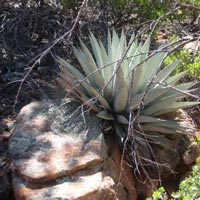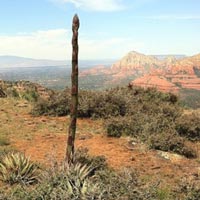One of our favorite sights in the high desert country surrounding Sedona is the abundance of wildflowers and blooming plants found everywhere in springtime.
From the gorgeous to the bizarre, we never seem to tire of going in search of them.
One of our favorite high mountain plants is the Agave Parryi, commonly known as a Century Plant or Parry’s Agave.

 “Century” is not an accurate description of their lifespan. In actuality, plants grow for 25 to 40 years before creating their single flower stalk. During late spring and early summer we are treated to this odd sight.
“Century” is not an accurate description of their lifespan. In actuality, plants grow for 25 to 40 years before creating their single flower stalk. During late spring and early summer we are treated to this odd sight.
The succulent has a long history of importance to Native Americans. Archaeological research suggests that “orchards” of agave were grown and harvested for pit roasting.
The sweet, nutrient-rich hearts of the plant were a staple among early inhabitants of the area. As well, the plant was a source of many of their beverages, soap, fiber and medicines.
 Looking similar to an artichoke, gray-green Century Plants grow wild among boulders.
Looking similar to an artichoke, gray-green Century Plants grow wild among boulders.
Mature plants produce a stalk that looks much like asparagus. This stalk can grow as much as one foot per day.
As the sturdy stalk reaches a height from 8’ to 18’, “branches” emerge that hold saucer-like clusters of orange-red flower buds.
Like flames, 3” yellow flowers explode skyward as they open from the red buds on green stems.

 Parry’s Agave can easily be viewed along Highway 89A, from Mingus Mountain, to Flagstaff. Unfortunately, the plants’ preference for rocky slopes makes it sometimes difficult to photograph them, especially when driving the curvy roads of Mingus Mountain or in Oak Creek Canyon. One off-road opportunity to see the plants close-up is in the Schnebly Hill parking lot where the asphalt turns to rock on Schnebly Rd., about a mile from Tlaquepaque. Red rock passes are available here. A short walk from the parking lot usually provides many up-close views of flowering Century Plants in mid-June.
Parry’s Agave can easily be viewed along Highway 89A, from Mingus Mountain, to Flagstaff. Unfortunately, the plants’ preference for rocky slopes makes it sometimes difficult to photograph them, especially when driving the curvy roads of Mingus Mountain or in Oak Creek Canyon. One off-road opportunity to see the plants close-up is in the Schnebly Hill parking lot where the asphalt turns to rock on Schnebly Rd., about a mile from Tlaquepaque. Red rock passes are available here. A short walk from the parking lot usually provides many up-close views of flowering Century Plants in mid-June.
The Parry’s Agave plant sacrifices itself to grow its magnificent, thick stalk and flowers. Before blooming is complete, the plant begins to die.


The remains of once-magnificent Century Plants litter the red rock landscape.

For each Century Plant that gives up its life to produce a single, tall chandelier of flowers, young plants that have sprouted from its base, continue on. One spring, they too, will bloom with the same wild abandon of their parent plant.
For those who drive a high-clearance vehicle, such as Jeeps, Schnebly Hill trails are a great place to see and photograph Agave Parryi. Also, the hill climb leading toward Perkinsville, that takes off at the fire station in Jerome is another place where the Century Plants are abundant.

Additionally, many of the local Jeep tour companies drive visitors up Schnebly Hill and along other roads where Century Plants are found.